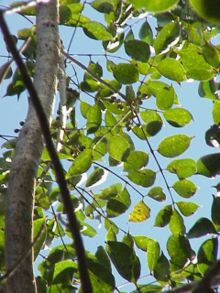Bursera: Difference between revisions
Content deleted Content added
m Task 16: replaced (2×) / removed (0×) deprecated |dead-url= and |deadurl= with |url-status=; |
No edit summary |
||
| Line 11: | Line 11: | ||
}} |
}} |
||
'''''Bursera''''', named after the [[Denmark|Danish]] [[botanist]] [[Joachim Burser]] (1583-1639), is a genus with about 100 described species<ref name = Becerra1>{{cite journal| last = Becerra| first = Judith X.|author2=D. Lawrence Venable| year = 2008| title = Sources and Sinks of Diversification and Conservation Priorities for the Mexican Tropical Dry Forest| journal = PLoS ONE| volume = 3| issue = 10| pages = e3436| doi = 10.1371/journal.pone.0003436| quote = no| pmid = 18927613| pmc = 2562985| editor1-last = Rees| editor1-first = Mark}}</ref> of flowering [[shrub]]s and [[tree]]s varying in size up to {{convert|25|m|ft|abbr=on}} high. |
'''''Bursera''''', named after the [[Denmark|Danish]] [[botanist]] [[Joachim Burser]] (1583-1639), is a genus with about 100 described species<ref name = Becerra1>{{cite journal| last = Becerra| first = Judith X.|author2=D. Lawrence Venable| year = 2008| title = Sources and Sinks of Diversification and Conservation Priorities for the Mexican Tropical Dry Forest| journal = PLoS ONE| volume = 3| issue = 10| pages = e3436| doi = 10.1371/journal.pone.0003436| quote = no| pmid = 18927613| pmc = 2562985| editor1-last = Rees| editor1-first = Mark}}</ref> of flowering [[shrub]]s and [[tree]]s varying in size up to {{convert|25|m|ft|abbr=on}} high. It is the type genus for [[Burseraceae]]. The trees are native (often for many species [[endemism|endemic]]) to the [[Americas]], from the southern [[United States]] south through to northern [[Argentina]], in tropical and warm temperate forest [[habitat]]s. |
||
A number of species from tropical [[Asia]] were once included in this genus, but are now treated in the genus [[Protium (plant)|''Protium'']]. |
A number of species from tropical [[Asia]] were once included in this genus, but are now treated in the genus [[Protium (plant)|''Protium'']]. |
||
Revision as of 12:12, 26 June 2020
| Bursera | |
|---|---|

| |
| Bursera simaruba | |
| Scientific classification | |
| Kingdom: | Plantae |
| Clade: | Tracheophytes |
| Clade: | Angiosperms |
| Clade: | Eudicots |
| Clade: | Rosids |
| Order: | Sapindales |
| Family: | Burseraceae |
| Genus: | Bursera Jacq. ex L.[1] |
| Type species | |
| Bursera simaruba | |
| Species | |
|
About 100, see text. | |
| Synonyms | |
|
Elaphrium Jacq. | |
Bursera, named after the Danish botanist Joachim Burser (1583-1639), is a genus with about 100 described species[2] of flowering shrubs and trees varying in size up to 25 m (82 ft) high. It is the type genus for Burseraceae. The trees are native (often for many species endemic) to the Americas, from the southern United States south through to northern Argentina, in tropical and warm temperate forest habitats.
A number of species from tropical Asia were once included in this genus, but are now treated in the genus Protium.
Species
Formerly placed here
- Canarium paniculatum (Lam.) Benth. ex Engl. (as B. paniculata Lam.)
- Protium serratum (Wall. ex Colebr.) Engl. (as B. serrata Wall. ex Colebr.)[4]
Uses
- Caranna, medicinal gum
Gallery
-
Bursera penicillata trunks
-
Bursera penicillata fruits and leaves
-
Bursera penicillata trunk
References
Wikimedia Commons has media related to Bursera.
Wikispecies has information related to Bursera.
- ^ "Genus: Bursera Jacq. ex L." Germplasm Resources Information Network. United States Department of Agriculture. 2007-10-05. Archived from the original on 2009-05-07. Retrieved 2010-11-18.
- ^ a b Becerra, Judith X.; D. Lawrence Venable (2008). Rees, Mark (ed.). "Sources and Sinks of Diversification and Conservation Priorities for the Mexican Tropical Dry Forest". PLoS ONE. 3 (10): e3436. doi:10.1371/journal.pone.0003436. PMC 2562985. PMID 18927613.
no
{{cite journal}}: CS1 maint: unflagged free DOI (link) - ^ Becerra, Judith X.; Noge, Koji (2010). "The Mexican roots of the Indian lavender tree". Acta Botanica Mexicana. 91: 27–36.
- ^ a b "GRIN Species Records of Bursera". Germplasm Resources Information Network. United States Department of Agriculture. Archived from the original on 2009-01-20. Retrieved 2010-11-18.
External links



